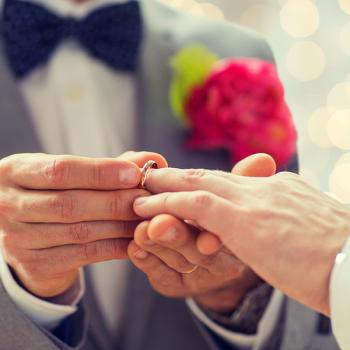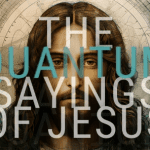By Rev. J. Dana Trent, MDiv
While Christianity is American’s most popular religion (70% of people in the U.S. identify as such), pastors and scholars all let out a collective gasp at the latest findings from the Pew Forum Religious Landscape Study. According to Pew, 2015 might be the year of the religious “nones,” as those who do not identify or affiliate with any faith tradition are on the rise, while the number those who call themselves “Christian” is declining. With an eight percentage point drop in just eight years, we are all wondering what American Christianity will look like in two or three generations.
 The bright (or bleak, according to some) spot in the latest Pew report? Since 2010, interfaith marriages have increased, and now four-in-ten Americans marry a spouse of a different religious group. This is a 20% increase since those who were wed prior to 1960.
The bright (or bleak, according to some) spot in the latest Pew report? Since 2010, interfaith marriages have increased, and now four-in-ten Americans marry a spouse of a different religious group. This is a 20% increase since those who were wed prior to 1960.
Trends in the decline of Christianity’s dominance and the rise of interfaith marriage might indicate shift towards a more open and progressive American spirituality. But, it doesn’t take much Googling to uncover advice against the modern paradigm of the “nones” and blended faith families. Naomi Schaefer Riley, journalist and author of ‘Til Faith Do Us Part, ignited the contemporary interfaith marriage conversation in 2013 with the publication of her research of such partnerships. Schaefer Riley is herself a willing participant in the interfaith marriage movement (she’s Jewish; her husband is a former Jehovah’s Witness), but still outlines the perils of such unions.
For decades, pastors and rabbis have contributed to the cacophony of concern: “divided” households lead to the confused religious lives of future children, and then there’s the age-old, much-debated Christian argument of being “unequally yoked,” with another, a phrase attributed to Paul the Apostle.
Do not be mismatched with unbelievers. For what partnership is there between righteousness and lawlessness? Or what fellowship is there between light and darkness? (2 Corinthians 6:14, NRSV)
But, how does a Biblical warning allegedly issued by a 1st century theologian bode for the would-be interfaith couples of 2015?
I was raised in rural North Carolina as a Southern Baptist who took the Bible literally. It was my infallible guide for life, and a simple yet unwavering faith marked my adolescence. I assumed that everyone who lived both in and outside of my tiny tobacco town was as steeped in Baptist beliefs as I was. I didn’t awaken to the possibility that folks practiced anything besides baptism by immersion until attended a Moravian women’s college for my undergraduate studies, and Duke University for seminary.
At school, I learned that the Bible is a complex, layered manuscript written over time whose canon took centuries to develop. There was far more to this book than the poetic King James sound bites that had rolled effortlessly off my 13-year-old tongue.
Armed with my deconstructed assumptions, I joined a progressive Baptist church whose members comprised mostly of retired university faculty. There were only a handful of already-married 20 and 30-somethings in our parish, and while my new faith community was intellectually and spiritually fulfilling, I was lonely. So, I did what many female Millennials raised in South do to a find “godly, Christian man”: I went online.
I took an intense eHarmony questionnaire which forced me to decide: was I open to dating someone of another faith? I checked all the “Big 5” of the world’s religions, certain I wouldn’t end up with anyone outside the Abrahamic faiths (Christianity, Judaism, and Islam). But, as luck—or providence—would have it, I was matched with a devout Hindu who lived as a monk and priest for five years.
Because my now-husband and I are each ordained in our respective Christian and Hindu traditions, our first dates consisted of theological talk, and we became serious students of one another’s religions. But the nay-sayers were already warning against our courtship, and so we tackled 2 Corinthians 6:14 head on, digging and wondering. The result was surprising.
An ancient scripture meant to deter us from getting involved with each other actually brought us together. Our core beliefs in God became the focus of our study and relationship, not the issues that divided us.
And, like good clergy, we consulted Biblical experts. A local scholar explained that, for the vulnerable and fledgling Christian faith of the first century, the chief concern was to spread the Gospel, not to impede it. The Greek for word “marriage” is not even used in this text, even though modern readings apply it to interfaith marriage. Rather, “yoked” signifies “work,” as one would yoke oxen together to plow or haul. Therefore a more effective way of interpreting 2 Corinthians 6:14 might be to consider the essence of what the author meant by “working” with unbeliever.
In first century, an “unbeliever” would have been anyone exposed to but was not faithful to Christ’s teachings—someone not characterized by devotion, love, peace, mercy, and forgiveness. In the context of the early Church, it’s easy to understand why Paul might caution those first generations of “believers” against being “yoked” with someone for whom Christ was not relevant. If the goal was the spread the Gospel, “working” with an unbeliever might have impaired it.
Today, my husband’s deep Hindu faith has taught me to dig deeper into what Jesus would have me do. Perhaps Paul might have even considered me an “unbeliever,” as I claimed to be a baptized Christian, but my life did not inwardly and outwardly reflect the Gospel. Since marrying Fred, I re-attuned my life to Christian spiritual practices: spending more time in contemplative prayer, practicing non-violence through a vegetarian diet, limiting my consumption, and increasing my service to others.
Much to many Christians’ dismay, it took a person of another faith—a seemingly “unequally yoked” partner, to strengthen my Christian walk.
The concerns over the tenacity it takes to be yoked to a partner of a different faith are certainly valid. But perhaps the more important question to pose is how each partner’s individual spiritual journey strengthens their collective faith and results in their passion to share God’s love.
Fred and I have found that it’s not so much about having the same faith as it is about having deep faith.
Om and alleluia.
Lead Photo: Shutterstock
 J. Dana Trent is an author and teacher. A graduate of Duke Divinity School, she is ordained in the Southern Baptist tradition. Her awarded winning book, Saffron Cross: The Unlikely Story of How a Christian Minister Married a Hindu Monk tells the story of her eHarmony-born interfaith marriage. Dana blogs at jdanatrent.com and tweets @jdanatrent.
J. Dana Trent is an author and teacher. A graduate of Duke Divinity School, she is ordained in the Southern Baptist tradition. Her awarded winning book, Saffron Cross: The Unlikely Story of How a Christian Minister Married a Hindu Monk tells the story of her eHarmony-born interfaith marriage. Dana blogs at jdanatrent.com and tweets @jdanatrent.
















